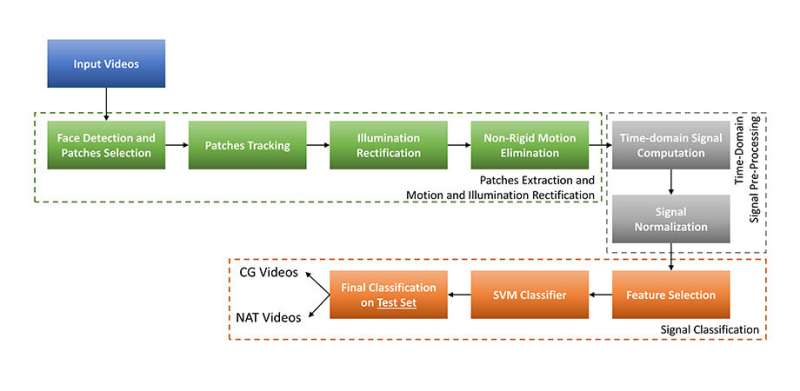Algorithm process flow. Three main phases characterize the workflow: (a) temporal signal computation from face patches and denoising; (b) signal normalization; and (c) feature extraction and SVM classification. Credit: Bonomi and Boato
Recent advances in computer graphics are making it possible to create computer-generated (CG) representations of human beings that are difficult to distinguish from their real-world counterparts. "Digital human face detection in video sequences via a physiological signal analysis," a paper published today in the Journal of Electronic Imaging (JEI), presents an innovative way to discern between natural humans (NAT) and CG faces within the context of multimedia forensics, using individuals' heart rate as the discriminating feature. JEI is co-published by SPIE, the international society for optics and photonics, and by the Society for Imaging Science and Technology (IS&T).
Humans present a pulse signal that can be automatically extracted from a video sequence; virtual humans do not. In their paper, Mattia Bonomi and Giulia Boato demonstrate that by focusing on an algorithm for pulse-rate estimation from human faces and calculating statistics from that heart rate, they can classify the input face as CG or NAT.
"Recent advances in machine learning and computer graphics have led to the rapid development of 'deepfakes,' where the face of a real person in a video is replaced by a computer generated one," notes JEI Editor-in-Chief Karén Egiazarian. "This technology is openly available nowadays, and, together with its wide use in the movie industry and advertisements, it has been also used by fraudsters. But how to distinguish a human face from a computer generated one? Bonomi and Boato address this question by proposing and applying a physiological signal analysis, extracting the heart rate from the video of human face, and using it as a discriminating factor."
The article authors are Mattia Bonomi and Giulia Boato, both of the University of Trento, Department of Engineering and Computer Science, Trento, Italy.
More information: Mattia Bonomi et al, Digital human face detection in video sequences via a physiological signal analysis, Journal of Electronic Imaging (2020). DOI: 10.1117/1.JEI.29.1.013009
Provided by SPIE
























